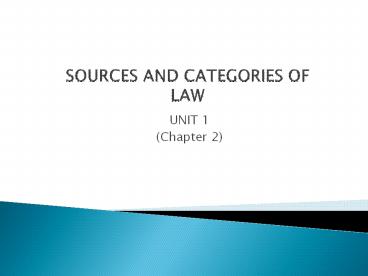SOURCES AND CATEGORIES OF LAW - PowerPoint PPT Presentation
1 / 20
Title:
SOURCES AND CATEGORIES OF LAW
Description:
UNIT 1 (Chapter 2) Primary Sources: Religion and Morality Historical Influences Customs and Conventions Social and Political Philosophy Secondary Sources of Canadian ... – PowerPoint PPT presentation
Number of Views:136
Avg rating:3.0/5.0
Title: SOURCES AND CATEGORIES OF LAW
1
SOURCES AND CATEGORIES OF LAW
- UNIT 1
- (Chapter 2)
2
Sources of Canadian Law
- Primary Sources
- Religion and Morality
- Historical Influences
- Customs and Conventions
- Social and Political Philosophy
- Secondary Sources of Canadian Law
- The Constitution
- Statute Law
- Case Law
3
Primary Sources of Canadian Law
- 1. Religion and Morality
- Judeo-Christian influence (God)
- Morality Right vs. Wrong behaviour
- (As determined by society)
4
Primary Sources of Canadian Law
- 2. Historical Influences
- Greeks (participation, jury)
- Romans (written codes, lawyers)
- Aboriginal (consensus, constitution)
- British (case law, rule of law)
- French (civil code)
- https//www.youtube.com/watch?voDALXORbtR4
5
Primary Sources of Canadian Law
- 3. Customs and conventions
- Laws are supported by established ways that
society has of doing things. - These practices often find their way into the
laws.
6
Primary Sources of Canadian Law
- 4. Social and Political Philosophy
- These change over time and new laws must address
these changes. - Tied to changing societal values
7
Secondary Sources of Canadian Law
- 1. The Constitution
- The supreme law of the land
- body of law which deals with the distribution and
exercise of govt powers. - Overrides statute and case law
- Make sure all law consistent with the
Constitution. - If a law violates the constitution it may be
thrown out by the courts. (Ex. Abortion law) - Constitution is referred to as the Constitution
Act of 1982(formally BNA Act)
8
Secondary Sources of Canadian Law
- 2. Statute Law
- Made by Federal and Provincial legislatures
- Gives lawmaking power to democratically elected
reps - refers to a law or act passed by government.
Statutes override common law.if there is no
statute then the common law applies.
9
Secondary Sources of Canadian Law
- 3. Case Law or Common Law
- Evolves through decisions by judges
- The highest court to make a decision will set a
precedent that all similar cases must follow. - Case Law can be changed by new Statute Law, but
both must defer to Constitutional Law.
10
Categories of Law
- Substantive and Procedural Law
- Domestic and International Law
- Public and Private Law
11
(No Transcript)
12
Categories of Law
- Domestic Law
- Applies within the boundaries of a nation
- Can be enforced by the government and interpreted
by domestic court authority - In Canada, this process is carried out within the
democratic process
13
Categories of Law
- International Law
- Consists of agreements between nations, often
through an international body such as the UN - Difficult for all countries to agree on these
laws - Even more difficult for these laws to be
enforced, due to political factors
14
(No Transcript)
15
Categories of Law
- Substantive Law
- Identifies the rights and duties of a person or
level of government
16
Categories of Law
- Procedural Law
- Outlines the methods or procedures that must be
followed in enforcing substantive laws
17
(No Transcript)
18
Categories of Law
- Public Law
- Refers to those laws which apply to dealings
between individuals and the state - Includes branches of constitutional law,
administrative law, and criminal law
19
Categories of Law
- Private Law
- Refers to those laws that apply to dealings
between private individuals or organizations - Also referred to as civil law
- Includes tort, property, contract, estate,
corporate, consumer and family law
20
- Figure 2.8 Categories of Law, p. 45
- Private law is divided into tort law, contract
law, family law, wills and estates law, property
law, and employment law.






























